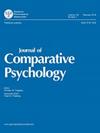Using isochrony, but not meter, to discriminate rhythmic sequences in rats (Rattus norvegicus).
IF 1.1
4区 心理学
Q4 BEHAVIORAL SCIENCES
引用次数: 0
Abstract
Meter induction is a key process for rhythm perception. However, while some nonhuman animals readily detect temporal regularities and perceive beats in auditory sequences, there is no consistent evidence that they extract metrical structures. In the present experiment, we familiarized rats (Rattus norvegicus) to auditory rhythmic sequences that evoked a duple or a triple meter. We then tested their recognition of these familiar sequences when pitted against novel sequences that evoked no meter (isotonic), evoked a different meter (either duple or triple), or were nonmetrical (nonisochronous). The animals only discriminated isochronous from nonisochronous sequences. However, we found no evidence for meter induction, as the animals did not discriminate familiar from isotonic sequences or from sequences with a different meter. The findings suggest that, under a familiarization paradigm, the natural tendency of the animals is to focus on temporal rather than melodic changes to recognize rhythmic sequences. (PsycInfo Database Record (c) 2024 APA, all rights reserved).利用等时性而非节拍来区分大鼠(Rattus norvegicus)的节律序列。
节拍归纳是节奏感知的关键过程。然而,尽管一些非人类动物很容易发现时间规律并感知听觉序列中的节拍,却没有一致的证据表明它们能提取节拍结构。在本实验中,我们让大鼠(Rattus norvegicus)熟悉能唤起二拍或三拍的听觉节奏序列。然后,我们将这些熟悉的序列与无节拍(等节拍)、不同节拍(二拍或三拍)或非节拍(非等节拍)的新序列进行对比,测试它们对这些序列的识别能力。动物只能区分等节律和非等节律序列。然而,我们并没有发现节拍诱导的证据,因为动物并不区分熟悉的节拍序列和等节拍序列,也不区分不同节拍的序列。研究结果表明,在熟悉范式下,动物识别节奏序列的自然倾向是关注时间变化而非旋律变化。(PsycInfo Database Record (c) 2024 APA, 版权所有)。
本文章由计算机程序翻译,如有差异,请以英文原文为准。
求助全文
约1分钟内获得全文
求助全文
来源期刊
CiteScore
3.30
自引率
7.10%
发文量
0
审稿时长
>12 weeks
期刊介绍:
The Journal of Comparative Psychology publishes original research from a comparative perspective
on the behavior, cognition, perception, and social relationships of diverse species.

 求助内容:
求助内容: 应助结果提醒方式:
应助结果提醒方式:


